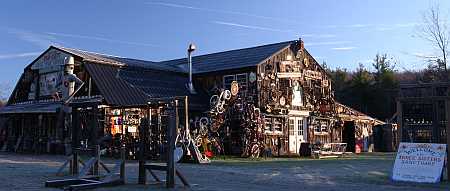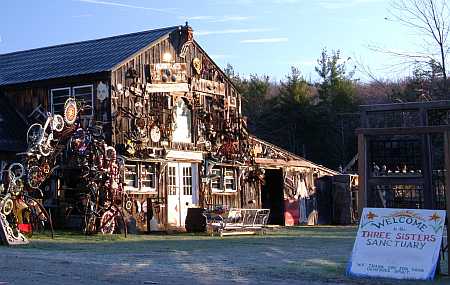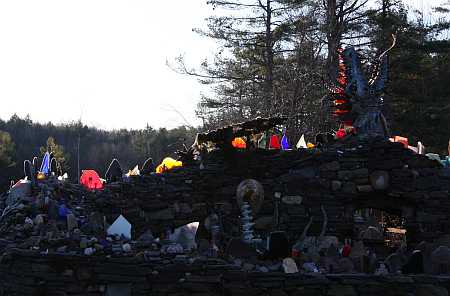Ofttimes, fashions that once seemed dated or even eccentric have a way of surfacing when they satisfy either whim or necessity. Such is the case for the wood stove today.
Dictated by economics, concern for supplies of fossil fuels, and nostalgia-heating the public consciousness if only as a supplement for one's present heating system or to have as a standby in case of power failure, repeated fuel crises, or steeply rising costs.
Before you catch this fever of self-reliance, however, there are several points worth considering, any of which may quickly dampen your enthusiasm: the availability and cost of a functional, safe stove; a method of installing it in your home; and the labor and/or expense of amassing the wood necessary to make your investment pay for itself.
Many countrymen who properly cull their woodlots have never deserted the stove as the sole source of heating their homes. For them cutting and working up a supply of seasoned, split hardwood each year is an integral part of their life in the country. Others have hung on to a stove as an auxiliary space heater to tide them over before and after it is cold enough to justify turning on the central heating.
Even urbanites today-attracted heat source either from stove or fireplace-are and healthful kind of outdoor recreation (and a lot of hard work) in the process.
If you decide to go this way and heat with wood rather than add another layer or two of clothing and even retire earlier for the night, you must first find an efficient stove in good condition and then take all conceivable precautions to assure its safe installation and operation.
There is a wide variety of wood burning stoves available today as a result of the recent fuel crisis. Established companies that languished as anachronisms for the past quarter century have suddenly been propelled into greater production than ever and others have sprung up to duplicate ancient patterns or design boldly different ones. In addition, Americans have discovered foreign stove makers-principally from the Scandinavian countries. At one time their back orders stretched nearly as far as their distribution lines, but they are readily available now from many dealers in New England and at stiff prices.
For years the Franklin, potbelly, and box were the principal types of home heating stoves available. Some were beautifully simple; others were embellished with every possible type of ornamentation. Carefully tended and maintained, these have lasted for many years and many bear the labels of manufacturers long since passed into oblivion when central heating became fashionable and convenient. Some of the more recently made stoves will be fortunate if they see several seasons of use because they have been hastily designed, poorly constructed, and are made of metal that is questionable in its quality and thickness.
Their only justification is their low price.
Before committing yourself, investigate all possible products. Compare costs, efficiency, and even looks. Then talk with other stove owners.
You may be fortunate to find an antique stove in mint condition. But be prepared to pay for it. Any stove should be free from cracks. It should have all its parts in working order. Replacement parts for old stoves are hard to find, but sometimes you can locate a local welder to restore the stove and manufacture new parts. Consider the color of the metal. A stove that has been operated unwisely by running it at continuously high temperatures will show metal discoloration on the firebox, which may have weakened its seams and composition. Although rust will appear on any stove unless it has been carefully restored, this is usually a minor problem and can be corrected with a wire brush, several coats of stove blacking, and concentrated work.
Prices for new stoves vary although all are higher than they were two years ago. Some may hesitate to spend as much as the $300 to $400 required for some American and many foreign made stoves. This can be translated into a considerable amount of fuel oil even at today's prices. However, buying a wood stove-like arranging for a home mortgage-should not be considered an annual outlay. Both can be depreciated for as long as they are "functioning efficiently. Often the more you spend at this stage to assure safety, the greater the result in savings-possibly including your house and your health.
Fire is always a lurking threat, even more so in the country where help is likely to be farther away. Therefore, safety is the most important consideration in converting to wood stove heating.
After you have decided on the stove to fit your needs, the next step is to see how it is to be vented. All solid fuel stoves must be connected to a chimney or flue to transport the smoke and gases outdoors. The prudent householder will see that this is done in accordance with safety standards cited by stove manufacturers, local fire and building ordinances, and the recommendations of the National Fire Protection Association.
Existing chimneys can often be used to vent a new stove. However, certain precautions must be taken first. Check the condition of the chimney. This can be done by the homeowner visually or by the local fire department. Look for stains on the masonry (these may indicate smoke leaks from former years), and loose or cracked mortar (a possible avenue for sparks that could destroy your house). Any defects should be properly repaired.
Clay mortar was commonly used in unlined chimneys built more than seventy-five years ago. It is questionable whether any of these meet present day safety standards, but the customary sight of smoke rising from a two-hundred-year-old been rebuilt or modernized attests to their continued use.
If the condition of an old chimney dictates it, you can hire a mason to rebuild it or at least insert flue linings in it. This will be a major undertaking and expense. Otherwise, chimneys can be lined with metal linings that are made to specification. Some homeowners have installed sections of regular stovepipe-fastened machine bolts-by inserting them down the chimney to the stove connection.
Chimney tile-mortared together smoothly – or metal liners discourage the accumulation of creosote, which is one of the byproducts of burning wood-particularly woods-mid which may ignite and cause chimney fires. (There are chemicals available that can be burned on the fire to discourage creosote accumulation. A safer way is to clean your chimney each year before the real stove season starts. Do this by wrapping chains in a burlap bag, tying a rope around its neck, and raising and lowering it against the insides of the chimney walls. Be sure you have blocked the hearth and flue openings before you begin. This will prevent soot from permeating the house.) Soot and creosote will be less likely to accumulate if you burn a fire continuously. These by products are usually consumed satisfactorily but a visual inspection should be made.
If you use an existing flue for your wood stove, it should not be the same as that which is used for either the central heating vent or a working fireplace. Gases can be drawn downward and into the house while you sleep. For safety, therefore, you will have to make a list of priorities. Even if you decide to vent the stove through the over mantel of the fireplace, you will be giving up the use of the hearth as many did in the early days of "modernization" when wood stoves became fashionable and. known to be safer and more efficient than fireplace fires. (Even the best fireplaces-while cozy and heart-warming-are only about 10 percent to 20 percent efficient in their conversion of wood to heat; stoves are from 30 percent to more than 80 percent in the case of some of the Scandinavian imports.)
Should you not have a chimney at all through which to vent a stove, or if blocking off an existing fireplace or even using it safely without extensive renovation is considered either hazardous or unwise, you can beat the problem by installing a new chimney altogether. This can either be constructed of masonry (brick, stone, com- position blocks), which would call for the services of a mason and the resulting cost and bother, or a metal, prebuilt chimney. Never try to avoid the expense by venting your stovepipe through a window sash. This merely courts disaster.
Masonry chimneys start from below frost level on a poured concrete foundation and are built up; factory built metal chimneys, long known in the Midwest and introduced here principally for second homes after World War Two, are supported from the roof and
hang down; Money, time, and labor are saved by installing a prebuilt chimney. Several nationally known companies manufacture them and provide specific instructions for installing them. These can be followed accurately by anyone with a feeling for tools and the ability to read directions.
Chimneys can be built either inside a house or made to run up an outside wall. The advantage of housing the flue within a building is that of added choice of where to place the stove and more-even stovepipe temperatures. Unless the prebuilt chimney is inspected periodically during the heating season, the greatest disadvantage is that it brings the possibility of an unleashed fire closer.
Whatever kind of chimney you decide to install, make sure to observe the following points:
1. Stoves are heavy. Before bringing one into the house, check the underpinnings of the floor and strengthen them if necessary.
2. Wood stoves are radiant heaters. They must be kept at recommended distances from all combustible materials. Wood, wallpaper, many kinds of fabric, most kinds of paint, furniture, and even the woodpile itself are all potential fire hazards. A freestanding stove must be 36 inches from the nearest combustible material on sides, front, and back. If gypsum, plaster, asbestos, stone, or brick is used for wall sheathing, most stoves can be brought to within 12 inches from the wall. Some manufacturers state that if the noncombustible wall covering is 4 inches or more thick, their product can be placed as little as 6 inches from the wall. However, use your own discretion.
3. A noncombustible hearth should be provided under the stove and extend 18 inches out from the firing door, 12 inches out on either side. This can be a piece of asbestos encased in tin and can be purchased at a hardware store. Or you can make one of marble chips, shells, crushed gravel, brick, slate, etc., that is laid on a metal or asbestos fires top cut to the proper dimensions. Stoves on legs should have 18 inches or more of open space under them.
4. Common carbon steel or galvanized stovepipe should be 18 inches from walls and ceilings. The Shakers, ever an inventive and practical people, often located their wood stoves toward the center of the room and led a well-supported stovepipe at a slight angle under the ceiling to the chimney vent. This method provides added surface for additional heating.
5. Common flues must never pass through combustible ceilings or walls unless proper precautions are taken and recommended distances observed. Double and triple walled pipe are safe to use and easy to install. Even with a good fire going in the stove, they will only feel slightly warm to the touch. Manufacturers list specifications for clearances. If you do not use this product, cut a hole in the wall or ceiling that provides 18 inches of clearance around the pipe and fill this hole with noncombustible insulating material or brick work.
6. Factory-built chimneys should be 2 feet above the ridge of the house or 2 feet higher than any projection within 10 feet of it. These come with rain caps to prevent water from running down and extinguishing the fire. They can also be enclosed by bricks or brick like metal boxes to simulate a permanent masonry chimney.
7. It will be safe to use single walled stovepipe between sections of double-walled fittings that pass through ceilings if these are in a position to be inspected readily. However, if the chimney is inaccessible, built-in, or remote from frequent inspection, this additional means of heating a loft, for example, should not be considered. It would be better to invest in a full section or two of insulated pipe.
Even with the above points in mind as you contemplate installing a wood stove, it is still prudent to consult with your local fire department, study and follow the directions provided with the stove (if it is a new one), and request more information from the National Fire Protection Association.












 Antique wood stoves are valuable not just because of their age and rarity, but also because they are as relevant today as they were a century ago. A wood stove is a heating device that you can use as a stand-alone heating equipment or use as a fireplace insert. Antique woodstoves are popular because besides adding to the beauty of your home, they keep your house warm and can cook the food as well. Around the world, people have been using wood stoves safely and conveniently, for hundreds of years.
Antique wood stoves are valuable not just because of their age and rarity, but also because they are as relevant today as they were a century ago. A wood stove is a heating device that you can use as a stand-alone heating equipment or use as a fireplace insert. Antique woodstoves are popular because besides adding to the beauty of your home, they keep your house warm and can cook the food as well. Around the world, people have been using wood stoves safely and conveniently, for hundreds of years.






































